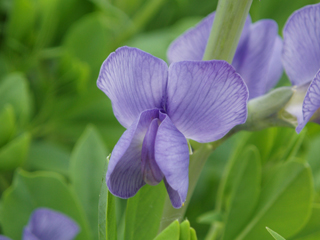So the other day when I featured the baptisia alba, I actually forgot that one of them is blue wild indigo, baptisia australis. The blooms are opening now and I have the white and the blue together, which is very nice.
I also had one in the other bed, but so far not seeing it come up this spring.
Here’s the blue wild indigo:
It’s going to be pretty when they’re both fully in bloom.
Also took a couple of shots of these beds from the garage level. Bob the truck is part of the landscape there after Elf The VW Beetle took a spot in the garage, so not quite as pristine a view as I’d like, but maybe someday Bob will get his own shelter again someplace else on the farm.
You can see that in these two terraced beds I have some room for more plants. I left space because I wasn’t sure how much these would spread - now I know. In the middle photo above you can see the fence where I’ve cleared weeds and still have goldenrod to move up there. Once I’m done with that, I’m going to be thinking what I might put in front of them in the fall.
In the bottom photo front and center, the space seems empty now, but the mountain mint will take that over by midsummer, and since it’s by far the most popular and long-lasting pollinator in the beds, I’ll give it plenty of room.
I’m going to move all the baby rattlesnake masters to the other side of the front walkway. Last spring we created a strip there - put down landscaping cloth to kill the grass, and put in compost and mulch. It’s been sitting for a year now, and I’ve only planted three plants along that strip. I think a grouping of rattlesnake master will do very well there, as it’s full sun much of the day and tends to be dry.
Yesterday I spent an hour finishing off the weeding on the terraced bed side, and removed a few sproutings of poison ivy. It was rampant in these two beds three years ago, and my farm helper got all of it out. We have to keep on top of it to prevent it coming back. I was careful, but came upon one plant underneath the bee balm and my inner forearm brushed the poison ivy leaves. For most of my life I haven’t reacted to it, but three years ago I got a bad case and had to take prednisone, so when I realized I’d touched it yesterday, I came in and washed with special soap. The best thing, Zanfel, recommended to me by the expert, Calm Forward Straight who sometimes comments here, I am out of - so ordering it today to have on hand.
I definitely have a patch of itchy bumps where it touched, but maybe washing it quickly will reduce the severity. We will see.
Today I’ll try to move some more goldenrod. Once I get them moved there will be a new fairly large space in the bottom front bed for something new and more appropriate sited with regards to height. I’m happy to have some space to think about new plantings in the fall. As I get to it, I’ll start featuring the native pollinator shade beds I’ve been working on for the past half year. The shade element is an entirely different beast and the two beds are nowhere near full yet, but where they are will really enhance the look of that side of the driveway and offer some rain run-off help to boot.
Here’s more info on baptisia australis:

Makin, Julie
Baptisia australis
Baptisia australis (L.) R. Br.
Blue Wild Indigo, Wild Blue Indigo, Blue False Indigo
Synonym(s):
USDA Symbol: BAAU
USDA Native Status: L48 (N), CAN (I)
Rising 2-4 ft. high from a woody base, blue wild indigo is a bushy, robust perennial. Flowers are blue-purple and pea-like, congested in dense, upright, terminal spikes, 4-16 in. long. Leaves are divided into three leaflets.
In late fall the plant turns silvery-gray, sometimes breaking off at ground level and tumbling about in the wind.
Like other members of the pea family, this plant requires the presence of microorganisms that inhabit nodules on the plants root system and produce nitrogen compounds necessary for the plants survival.












